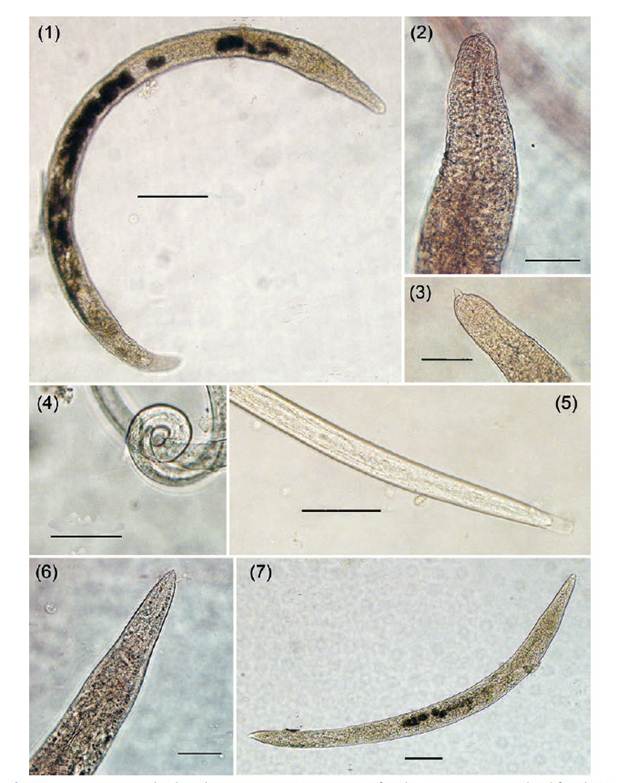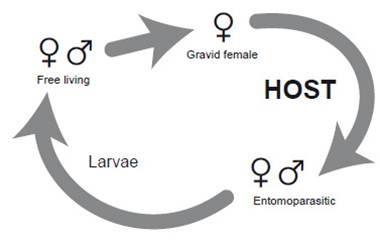Introduction
The genus Neoparasitylenchus was erected by Nickle in 1967. The type species N. cryphali was described by Fuchs in 1914 and placed in the genus Tylenchus, as T. cryphali. In 1922 Micoletzky located this species naming it Parasitylenchus dispar var. cryphali. Later, Filipjev (1934) put this species as Aphelenchys cryphali; meanwhile Schneider (1939) and Rühm (1956) accepted this species as Parasitylenchus dispar var. cryphali. Nickle (1967) conducted a study organizing the generic nomenclature of Tylenchida nematodes. At this moment 24 species have been described from the genus Neoparasitylenchus, within which only five were described as having free-living stages: N. amvlocercus Poinar & Caylor, 1974, N. cinerei (Fuchs, 1929) Nickle, 1967, N. cryphali (Fuchs, 1914) Nickle, 1967, N. hylastis (Wülker, 1923) Nickle, 1967, and N. pessoni (Fuchs, 1914) Nickle, 1967; all parasites of curcullionid hosts. In this paper we describe another species of the genus Neoparasitylenchus, N. platense sp. n., a parasite of Harmonia axyridis (Pallas, 1773) (Coleoptera, Coccinellidae) Harmonia axyridis Pallas, 1773, the multicoloured Asian lady beetle (Koch, 2003), which is introduced as a biological control agent that was rapidly spread all over Argentina (Saini, 2004). Despite the fact that they are an effective biological control agent in agricultural and landscape environments, they have become a major nuisance to homeowners because of their habit of invading houses and buildings in large numbers while searching for protected sites to overwinter in the fall (mid-May to early August) and appearing again on warm days in September and October (Saini, 2004). In addition, beetles may get in picnic food and drinks, "swarm" like bees and land on people (Brown, 2011). This species prey upon many species of injurious soft-bodied insects such as aphids, scales, and psyllids and it is thus considered beneficial for growers and agriculturalists. Ladybird is the name that has been used for more than six centuries in Europe for this coleopteran species.
Material and methods
Insects: adult coccinellid insects were collected by hand from September 2016 to April 2017 on plant species Cucurbita maxima var. zapallito (Carrière) Millán, 1947 (round green zucchini), at a locality near Gran La Plata, Colonia Urquiza (34°96'72”S, 58°04’96”W). The beetles were distributed in individual plastic containers. In total, 260 adults of Harmonia axyridis (Pallas, 1773) (Coleopera, Coccinellidae), were sampled and dissected. The coccinellids adults were dissected in Petri dishes filled with distilled water under a stereomicroscope. Nematodes: living nematodes were removed from the hemocel of adult host, and then they were killed by placing them in distilled water at 60 °C for 2 minutes. They were fixed in 50% TAF solution in water for 48 hours and then into pure TAF (Poinar 1975). All the specimens were used for photographing in Olympus BX51 microscope with Olympus DP71 camera. Measurements of common nematode body features were performed on 16 fixed nematode specimens of each nematode stage of life cycle. Mean and in parenthesis minimum and maximum.
Results
(Follow Siddiqi 2000)
Order Tylenchida Thorne, 1949
Suborder Hexatylina Siddiqi, 1980
Superfamily Sphaerularioidea Lubbock, 1861
Family Allantonematidae Pereira, 1931
Subfamily Allantonematinae Pereira, 1931
Genus NeoparasitylenchusNickle, 1967
Neoparasitylenchus platense sp. n.
(Figures 1 - 8)

Figures 1 7: Neoparasitylenchus platense sp. n. 1. Entomoparsitic female, 2. Entomoparasitic head female, 3. Entomoparasitic tail appendage female, 4. Posterior end of male, 5. Larva, 6. Free living female, 7. Free living head female. Bars= 1: 200 µm, 2, 3, 4, 5, 7: 50 µm, 6: 100 µm.
Description: Entomoparasitic female (n= 18): body worm-shaped, usually curved (Fig. 1). Cephalic region overgrown by body enlargement (Fig. 2). Light brown body. Stylet not sunken into body, and not prominent. Subterminal vulva and anus. Obtusely rounded tail end, with a peg-like projection (Fig. 3). Oviparous. Body length: 2,004 µm (1,655 - 2,100) ; width at midbody: 70 µm (68 - 82) ; length of stylet: 3,5 µm (3 - 4) ; head to excretory pore: 176.30 µm (168.42 - 180.25); head to nerve ring: 96.55 µm (72.50 - 122.32); tail length: 10.35 µm (10 - 11.50) ; length vulva to tail tip: 130 µm (124 - 145); length anus to tail tip: 50 µm (42 - 64)
Male (n= 16) (Fig. 4): little stylet and oesophagus partially degenerate, spicules filiform with widened base, short gubernaculum, leptodera bursa. Body length: 1,242 µm (1,200 - 1,320) ; width at midbody: 36 µm (24 - 47.55); head to excretory pore: 92 µm (90 - 120); head to nerve ring: 50 µm (45.50 - 56) ; tail length: 11 µm (10 - 12); spicules length: 15.50 µm (15 - 17); spicules width: 0.72 µm (0.7 - 0.8); gubernaculum length: 7 µm (6 - 7.5); length of leptodera bursa: 35 µm (32 - 38). The entomoparasitic and free living males are similar in morphometric data.
First stage larvae (n= 25) (Fig. 5): lip region flatly rounded, spear slender, faintly knobbed, oesophagus a narrow tube, with a broad nerve ring. Rounded tail.
Partially free-living females (n= 12): body vermiform (Fig. 6), cephalic region with a cap (Fig. 7), stylet with slight basal thickenings, dorsal gland opened near of stylet base, excretory pore posterior to nerve ring, vulva at about 90 % of body length, immature ovary but with some cells, conoid pointed and rounded tail. This female fertilized invades host´s larva. Body length: 1,080 µm (1,000 - 1,200); width at midbody: 68 µm (60 - 82); length of stylet: 2 µm (2 - 2.2); head to excretory pore: 213 µm (190 - 225); head to nerve ring: 154 µm (145 - 168); tail length: 8 µm (7 - 8.5); length vulva to tail tip: 126 µm (120 - 134); length anus to tail tip: 54 µm (52 - 62).
Type host: Indifferent parasitism in adult males and females of Harmonia axyridis (Pallas, 1773) (Coleoptera, Coccinellidae).
Type locality: Colonia Urquiza (34°96'72”S, 58°04’96”W), Gran La Plata, Buenos Aires, Argentina
Type material: Holotype and allotype deposited in Museo de La Plata, and paratypes deposited in Helminthological Collection of CEPAVE
Effects on the host: this parasite reduces the fat body and atrophies the gonads, sterilizing and then killing it.
Discussion
While conducting field surveys on horticultural pests in the horticultural belt, we found Harmonia axyridis parasitized by (Camino et al. 2016) Metaparasitylenchus Wachek, 1955 (Nickle, 1967), SulphuretylenchusRühm, 1956 (Nickle, 1967), Contortylenchus Rühm, 1956, and Camino et al. (2019) described a new species Parasitylenchus pseudobifurcatus. Now we found another genus and new species Neoparasitylenchus platense sp. n. There are only five species of the genus Neoparasitylenchus that we can compare with our new species since they are the only ones that described the free-living stages, but they can be separated as follow: Neoparasitylenchus amvlocercus the females with rounded tail, distinct mouth cone, stylet with faint or no thickenings, position of the vulva and lack of a crown-shaped lip region. Neoparasitylenchus cinerei has a pointed tail in free living female, the cone mouth in the parasitic female. Neoparasitylenchus cryphali presents a well-developed male stylet and a broad wide bursa. Neoparasitylenchus hylastis has basal swellings on the stylet leptodera bursa, and Neoparasitylenchus pessoni the adult parasitic female has a mouth cone and a pointed tail.
Neoparasitylenchus platense sp. n. is diagnosed by having the free living stages lip region flatly rounded, spear slender, faintly knobbed, rounded tail, females with light brown body, stylet not sunken into body, and not prominent, subterminal vulva and ano, obtusely rounded tail end, with a peg-like projection, oviparous, and the males with a little stylet and partially degenerate oesophagus, spicules filiform with widened base, short gubernaculum, leptodera bursa.
Life cycle of Neoparasitylenchus platense sp. n. (Fig. 8)
After mating, the free-living female enters an immature coccinelid H. axyridis (last larval instar or pupa), and remains in the adult stage where it is located in the body cavity and begins to parasitize the host. Larvae are born and transformed into entomoparasitic females and males, copulate and then larvae that reach in stage III leave the host. They suffer two molts in the environment. The free living females and males appear and the free-living males mate and the cycle is restarted.












 uBio
uBio 



